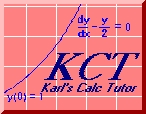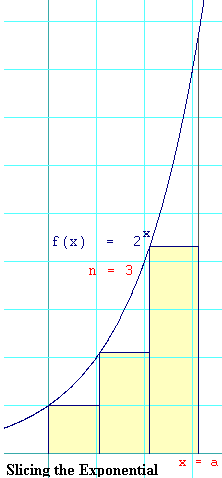

Along the x axis, the area you are interested goes from

The diagram shows the area under the exponential sliced into
three rectangles (
hk = f( (k-1)a/n ) = 2(k-1)a/n
Area is the base times the height. You determined that the base of every
rectangle is a/n. And you determined that the height
of the kth rectangle is
Ak = (a/n) 2(k-1)a/n
n
Atotal = å Ak
k=1
Now you have to substitute Ak with the expression
for it that you got in the previous step.
n
Atotal = å (a/n) 2(k-1)a/n
k=1
Clearly the a/n that is in multiplied by the exponential function is constant with respect to k. So we factor that out.
n
Atotal = (a/n) å 2(k-1)a/n
k=1
bpq = (bp)q = (bq)pThis is the identity you need to use here. Your exponent is the product of
n n
Atotal = (a/n) å (2a/n)(k-1) = (a/n) å (2(k-1))a/n
k=1 k-1
So which one to use? Well the first has the expression, (2a/n),
raised to the (k-1) power. The significance here is that
(2a/n), is constant with respect to the
index variable, k. So if you substituted
u = 2a/nYou would have
n
Atotal = (a/n) å uk-1
k=1
Look familiar? You can apply the summation formula given at the beginning
of the problem to this.
The summation formula tells you that
n un - 1
å uk-1 =
k=1 u - 1
Stick that in for the summation in what we already have and you get
un - 1
Atotal = (a/n)
u - 1
When you substitute back the
(2a/n)n - 1
Atotal = (a/n)
2a/n - 1
But now you can use that exponential identity again. Remember? It
means that
2a - 1
Atotal = (a/n)
2a/n - 1
When you make the suggested substitution, you get
2a - 1
Atotal = h
2h - 1
You now have the limit of this as h goes to zero. But rearrange this
thing just a little, and you have
h
Atotal = (2a - 1)
2h - 1
Do you remember from Exponentials and Logarithms what the
limit definition of natural log is?
bh - 1
lim = ln(b)
h > 0 h
So when you take the limit as h goes to zero of
h
2h - 1
you're going to get 1/ln(2). So the final result is
2a - 1
Atotal =
ln(2)
email me at hahn@netsrq.com